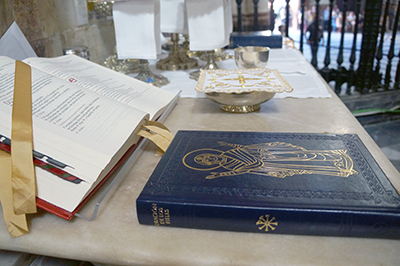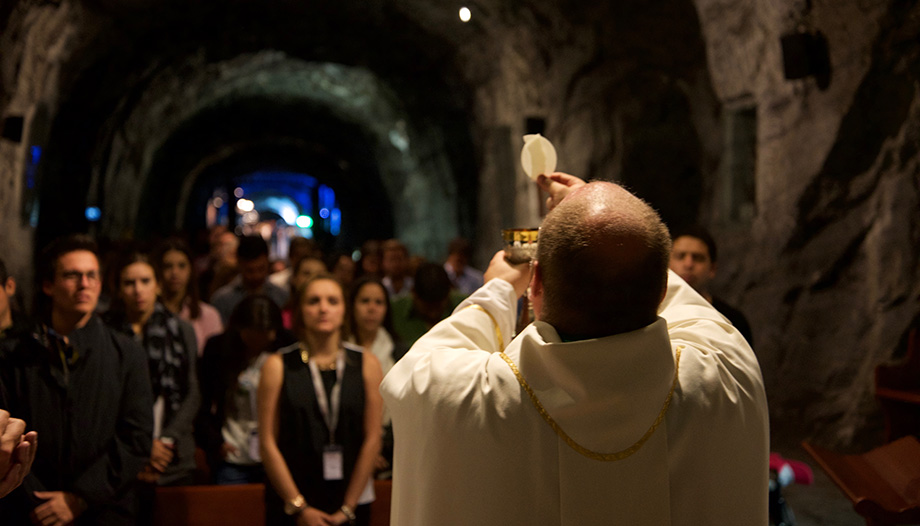We often recall an affirmation of the Second Vatican Council: "The Holy Eucharist contains all the spiritual good of the Church". A profound and clear affirmation. Yes, in it resides Christ himself, our Passover and the Manna of Life. The Eucharist represents the gift of boundless generosity, love stretched to an unreasonable extreme. The Eucharistic mystery is the living heart of the great cathedrals and also of the small mission wayside shrines. Its celebration is an action of extraordinary richness, to which we would like to refer.
In order to rediscover this treasure-an ongoing task-we will briefly mention a note which, at first glance, might seem peripheral, but which, in reality, is not so peripheral. We refer to the greeting "the Lord be with you" which is repeated four times throughout the celebration. That, in it, Christ is the Liturgist on whom the fruit of the celebration depends, more than on the other participants, is what "the Lord be with you" means.
When this greeting had to be translated into Spanish, back in the seventies of the last century, its translation was not easy. One could say "el Señor esté" or "el Señor está". Both had advantages and disadvantages. In the subjunctive, the verbal form "esté" points to a desire, something desiderative: that is, hopefully Christ will be more deeply rooted in you; but it lacks the realistic nuance of "está" in the indicative. The Latin language offers a total solution, omitting the verb "to be" -Dominus vobiscum- and thus, with the elliptical verb, it embraces both aspects at the same time. Both "está" and "esté" fit together.
At the beginning of the Mass: presence in the assembly

At the beginning of the celebration, the assembly is greeted by saying "the Lord be with you". This expression denotes the presence of Christ in the liturgical community gathered here and now. "Where two or more are gathered in my name, there am I in their midst." It is a real presence, not merely intentional.
With the entrance song, the assembly shows that it - the Bride - gratefully welcomes the presence of the Bridegroom, who comes to celebrate for her his divine Mysteries. The assembly of the faithful is not a conglomerate of people who obey purely sociological laws. Every baptized person is called to be, together with other Christians, and especially on Sunday, a symbol of a communion that is above our divisions, to such an extent that St. Cyprian says that "the Church is unified in the image of the Trinity. Every Eucharistic assembly is a local congregation of the universal Church, a sign that manifests her. The Lord is with her. He convokes it. The holy assembly is a foretaste of the heavenly Jerusalem, a figure and proclamation of a hope that will find its fulfillment beyond space and time.
Before the Gospel: presence in the Word
A little later, as the celebration proceeds, the deacon addresses the assembly, before proclaiming the Holy Gospel, with the greeting: "The Lord be with you". It is the presence of Christ in his word. Real presence too.
In the liturgical celebration of the word of God, the Risen Christ is the divine "Proclaimer" and his Spirit is the divine "Actualizer" of that word in the heart of the assembly and of each of the faithful who make up the assembly. The presence of Christ is affirmed, the presence of the Holy Spirit is affirmed. God the Father, as Irenaeus of Lyons writes, works through his two arms: the Son and the Spirit. Here too. He who spoke through the prophets is the same one who now speaks through the reader. The mysterious contemporaneity of Christ with the assembly, which generates the liturgical celebration, allows the faithful to hear the word in its nascent state, as coming from the lips of the Risen One. And they see it grow before their eyes and ears with the amazement of those who witness an epiphanic experience. This is what is hidden behind this "the Lord be with you".
An expression that we are accustomed to hearing and to which we could respond with a certain routine, certainly reveals a reality of faith of great depth: the multiple real presences of Christ in his Church.
Félix María Arocena
In the preface: presence in the one who celebrates
For the third time, the same greeting is heard at the beginning of the preface: "The Lord be with you"; "Let us lift up our hearts"... This time, the presence of Christ in the Bishop or in the priest who presides the celebration.
The Eucharistic prayer is about to begin, the moment when heaven is closest to earth. Prayer of Christ and of the Church in whose bosom the whole work of our redemption is accomplished. Prayer that demands the sacrament of Holy Orders in those who pray it. in persona Christi, because the bishop or the priest pronounces "this is my Body", and it is not his; this is my blood, and it is not his. Performative words, which do what they say. And where there was bread, there is now the glorious flesh of Christ; and where there was wine, there is now his precious Blood. And all of this - the "transubstantiation" - preceded by that Dominus vobiscum, which acts as a wake-up call to help us discover that it is Christ, whom we hear in the voice of the priest, who speaks the words. For him, this greeting is a wake-up call that invites him to recognize that he is overcome by a mystery that transcends him absolutely; for the community, it is an opportunity to verify at that moment whether its heart is truly lifted up to participate in the eternal Liturgy of the Jerusalem of heaven.
Final blessing: envoys
Finally, before imparting the final blessing to the assembly, the priest greets the assembly for the fourth time: "The Lord be with you". This expression is said with a precise intention. Like the three preceding ones, it again points to a new real presence of the Lord in the midst of his own, gathered to celebrate his Passover, his passage from this world to the Father. The faithful have just received the Body and Blood of Christ. They are what they have taken. This new greeting is a confirmation that they have been christified. The Lord is with them and now they are ready for their mission: "Glorify God with your lives; you can go in peace". At the beginning of the Mass they were "con-vocated" by the Lord and now, at the end, they are "sent" for the mission of the Church. And they are so once they have become one body and one spirit with Christ.
Here is how an expression that we are accustomed to hearing every Sunday several times during the Eucharistic celebration and to which we could respond with a certain routine, certainly reveals a reality of faith of great depth: the multiple real presences of Christ in his Church, especially in liturgical action. In it, the Risen One has committed himself not to miss the appointment of this "encounter".
Perhaps we are now in a position to grasp a little better the teaching of the Sacrosanctum Concilium: "Christ is present in the sacrifice of the Mass, whether in the person of the minister... or especially under the Eucharistic species. He is present with his power in the Sacraments, so that when someone baptizes, it is Christ who baptizes. He is present in his word, for when Sacred Scripture is read in the Church, it is he who speaks....".
If a simple greeting, such as "the Lord be with you," clears this broad theological and spiritual horizon, what other riches of meaning can we not find in other equally important elements of the Ordinary of the Mass?
Liturgist. Faculty of Theology. University of Navarra











